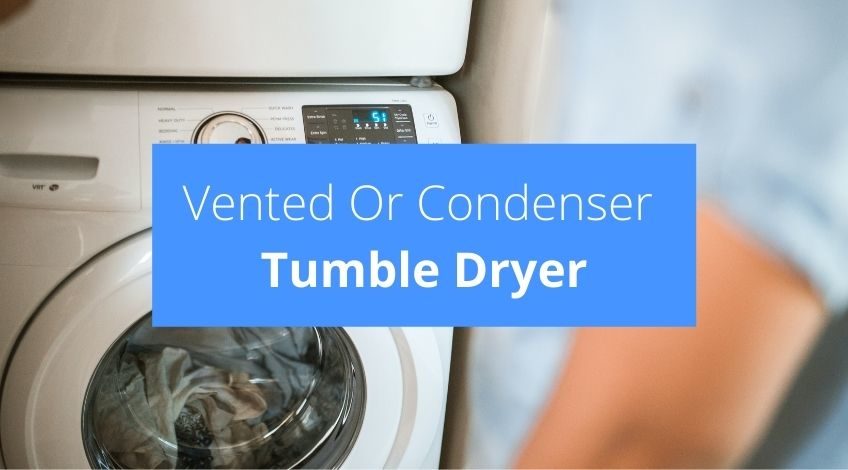
Which Is Better Vented Or Condenser Tumble Dryer?
When it comes to buying electrical appliances, there are so many choices that even simple things become confusing. None more so than when buying a tumble dryer. You need to choose between a vented tumble dryer or a condenser tumble dryer, but what do those names mean, and how do they differ?
More importantly which one is right for you, your home and your lifestyle? To be able to answer that question you’ll need to know more about the different types of tumble dryers, how they work and do the differences make any actual difference to you. So let’s have a look at both types of tumble dryers to give you some idea on how they work and what’s the best choice for you.
What Is A Vented Tumble Dryer?
Both vented and condenser tumble dryers remove moisture from washing in order to dry it. The differences are in how they deal with that moisture. Vented tumble dryers rely on a long hose to remove the moisture from the machine.
This hose usually connects to the front of the tumble dryer and the other end is placed outside the house where the moisture is ejected as steam. Having a hose to vent the water, means the tumble dryer will need to be situated near an outside door, wall or window.
They work by drawing air in from the outside and heating it, as it passes through the wet washing the hot air causes the moisture to evaporate and the water leaves the machine by the hose in the form of steam.
What Is A Condenser Tumble Dryer?
Condenser tumble dryers work by condensing the warm air from the wet clothes into water that then drips into a tank or reservoir. It does this by having 2 air flows going at once, one is cool air that cools the condensing plates, and the other is warm air that flows through the clothes absorbing moisture as it flows. To work efficiently these plates and any filters need cleaning regularly, in fact, some after every use.
When the water reservoir is full, it will need emptying, most modern machines have warning lights that let you know when the tank needs emptying. As there is no external venting on a condenser tumble dryer, they can be placed in any room, anywhere in the home, without the need for an external wall, door, or window.
Which Type Of Tumble Dryer Is The Most Energy-Efficient?
As with all electrical products sold in the UK, tumble dryers are subject to energy -efficiency ratings. A++ are the most energy-efficient. The rating system goes as far as G which is the least energy-efficient. The higher the rating the more expensive the appliance costs to buy. It’s sometimes worth going for a B-rated model as these might cost slightly more to run, but they can be substantially cheaper to purchase.
| Type of tumble dryer | Average cost per use (UK pence) |
|---|---|
| Condenser tumble dryer | 79 pence |
| C-rated vented tumble dryer | 44 pence |
| A-rated vented tumble dryer | 31 pence |
As you can see vented tumble dryers are considerably cheaper to run. That said a condenser tumble dryer costs less than the price of a cup of coffee and this doesn’t seem like too great an expense. But if you compare it with the average cost of using an A-rated washing machine, which is 26 pence, you can see that condenser tumble dryers use around 3 times the energy of a washing machine, and twice as much as a vented tumble dryer.
What Is The Average Price Of A Tumble Dryer?
Depending on the size, make, model, energy rating and colour, you can expect to pay around:
- £150 for a 3 kg vented C-rated tumble dryer
- £320 for a 7 kg B-rated vented tumble dryer,
- £190 for a 7 kg, B-rated condenser tumble dryer
- £650 for an 8 kg, A++-rated, condenser tumble dryer with a self-cleaning condenser, automatic sensor control and a 2-year guarantee.
What Are The Pros And Cons Of Vented And Condenser Tumble Dryers?

Now we are all slightly more familiar with what they are and how they work, let’s look at the pros and cons of each type of tumble dryers.
| Function | Vented tumble dryer | Condenser tumble dryer |
|---|---|---|
| Drying clothes | Yes | Yes |
| Faster drying time | Yes | No |
| Limited positioning | Yes | No |
| Energy-efficiency | Yes | Yes |
| Requires more maintenance | No | Yes |
| Costs less to purchase | Yes | No |
As you can see there are good and bad points to both, they both dry clothes, but a vented machine costs less to buy, and less to run. A condenser tumble dryer can be placed anywhere and is not limited to needing to be close to an external wall, window or door, but they do require more maintenance. The reservoir will need emptying regularly and the filters and condenser plate need regular cleaning too.
Condenser Tumble Dryer Vs Vented Tumble Dryer – What Should You Buy?
To be fair to both, the technology has come a long way in the past few years and whether you decide on a vented or condenser tumble dryer they are both much more energy-efficient and they both offer many extra features. So that’s not much help, but if drying clothes fast is your main concern then a vented tumble dryer is probably best for you.
However, if you have no access to an outside wall, window or door then a condenser will probably suit you better. But bear in mind, condensers take longer to dry and need more maintenance than vented models. That extra time will be burning extra power too.
Heat Pump Tumble Dryers
We couldn’t finish this post without mentioning heat pump tumble dryers. These are a fairly new innovation in the world of tumble dryers, they’re the most expensive to buy, but also the most eco-friendly tumble dryers available. They work using low-temperatures and reusing the hot air to dry the washing.
They boast no external pipes or hoses, so they can be situated anywhere. And they cost way less to operate. Heat pump tumble dryers tend to take more time than even condensers but only by 5 to 10 minutes.
A really energy-efficient model will cost around £34 per year to run, compared to around £79 per year for traditional types of tumble dryers. However, that saving on energy consumption, comes at a price. You can pay anything from £350 for a basic model with an A+-rating and 7 kg capacity, and up to £1000 for a top of the range model with an A+++-rating, 8 kg drying capacity, and WIFI-smart phone technology.
Frequently Asked Questions
The best type of tumble dryer depends on your situation. If you have no access to an exterior wall, door or window, the best for you is a heat pump tumble dryer or if you’re looking for a cheaper option a condenser tumble dryer. But if you have space for the hose to vent outside, then a vented will probably be best for you as they are cheaper to buy.
Condensing tumble dryers can cause damp, as they give off heat that could possibly condense on cooler surfaces.
Condenser tumble dryers do take longer than vented tumble dryers.
Some condenser tumble dryers do need plumbing in, but most have a water collection tank.
You can keep your condenser tumble dryer in a cupboard, but as it needs cool air to operate it would be wise to keep the cupboard door open.
You can put a condenser tumble dryer anywhere in your home because they don’t need to be vented, so there’s no need to place it near an outside door, wall or window.
A good price for a tumble dryer depending on the make, model, type and features is around £150 for an entry-level vented tumble dryer.
It is worth repairing a tumble dryer if it’s under 5 years old, if it’s older, it’ll probably be more cost-effective to buy a new one.
A tumble dryer should last between 10 and 13 years on average.
You should probably replace your tumble dryer after around 10 years even if it hasn’t broken down. After 10 years the parts will be starting to wear out.





![AEG 7000 SensiDry Freestanding Tumble Dryer TR718L4B, 8 kg, Heat Pump Technology, Gentle Drying, PreciseWash Adjust Time & Energy Usage Based On Load Size, White [Energy Class A++]](https://m.media-amazon.com/images/I/41pScU0EV6L._SL160_.jpg)



